List of the Cenozoic life of Washington
Appearance
This list of the Cenozoic life of Washington contains the various prehistoric life-forms whose fossilized remains have been reported from within the US state of Washington and are between 66 million and 10,000 years of age.
A
- Abdiunguis
- Abies

Fossilized twig and foliage found near Curlew from the Eocene fir tree Abies milleri
- Acanthocardia
- Acer[2]
- †Acer arcticum
- †Acer beckianum - type locality for species[3]
- †Acer bendirei
- †Acer browni[4]

Fossilized leaf found near Spokane; the holotype specimen of the Oligocene-Miocene maple tree Acer chaneyi - †Acer hillsi - type locality for species[4]
- †Acer knolli - type locality for species[4]
- †Acer latahense - type locality for species[4]
- †Acer medianum[4]
- †Acer niklasi[4]
- †Acer olearyi - type locality for species[3]
- †Acer puratanum - type locality for species[3]
- †Acer republicense - type locality for species[4]
- †Acer spitzi - type locality for species[4]
- †Acer stonebergae[4]
- †Acer tigilense[4]
- †Acer toradense - type locality for species[4]
- †Acer washingtonense - type locality for species[4]
- †Acer wehri - type locality for the species[4]
- †Acer whitebirdense[4]
- Acharax
- †Acherontemys – type locality for genus
- †Acherontemys heckmani – type locality for species
- Acidota
- Acila
- Aclypea
- Acrulia
- Actium
- †Acutostrea
- †Adamsochrysa
- †Adamsochrysa wilsoni – type locality for species
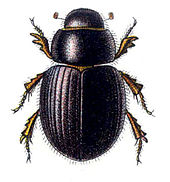
Illustration of an Aegialia dung beetle - Aesculus[2]
- †Aesculus hankinsii - type locality for species[5]
- Aforia
- Agabus
- Agathidium
- †Aglyptorhynchus
- †Aglyptorhynchus columbianus – type locality for species
- Agonum
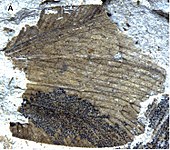
Fossilized wing and holotype specimen of the Eocene lacewing Ainigmapsychops - †Ainigmapsychops inexspectatus – type locality for species[6]
- †Alilepus
- †Alilepus vagus
- †Alilepus wilsoni – or unidentified comparable form
- †Allantodiopsis
- †Allantodiopsis erosa[7]
- †Allantodiopsis pugetensis[8][2]
- †Allantodiopsis undescribed species[2]

Fossilized skeleton of the Miocene seal Allodesmus - †Allophylus
- †Allophylus duktothensis – or unidentified comparable form
- †Allorapisma – type locality for genus[9]
- †Allorapisma chuorum – type locality for species[9]
- Alniphagus
- Alnus
- †Alnus carpinoides[10]
- †Alnus kluckingi - type locality for species[8]
- †Alnus operia[8]

A fossilized leaf found in Republic from the Eocene Alder species Alnus parvifolia
- Altica
- †Altica lazulina – or unidentified comparable form
- Amaea
- Amara
- †Amara conflata – or unidentified comparable form
- Amauropsis
- Amia
- Ammospermophilus
- Amphimorphina
- Amphistegina

Fossilized skeleton found in Republic belonging to the Eocene-Oligocene sucker fish Amyzon aggregatum - †Anacardites
- †Anacardites franklinensis – type locality for species[8]
- Anadara
- †Anadara devincta
- †Anadara lakei – or unidentified related form
- †Anamirta
- †Anamirta milleri – or unidentified comparable form
- Ancistrolepis
- †Anechinocardium
- †Anechinocardium lorenzanum
- †Anechinocardium weaveri – or unidentified comparable form
- Anemia[7]
- Anthrax
- †Anthrax dentoni – type locality for species
- †Aperiploma
- †Aphelops
- †Aphelops mutilus – or unidentified comparable form
- Aphodius
- Aphrocallistes
- †Aphrocallistes polytretos – or unidentified comparable form
- Apion
- †Aporolepas
- †Arceuthobium
- †Archarax
- Arcoscalpellum
- †Arcoscalpellum knapptonensis – type locality for species
- †Arcoscalpellum raricostatum
- †Arctostaphylos

Shell of an Argobuccinum triton sea snail - Arpedium
- Artemisia
- Artochia
- Asiorestia
- †Asplenium
- †Asplenium delicata – or unidentified comparable form
- Astrangia
- †Astrangia clarki – type locality for species
- Astreopora
- †Astreopora duwamishensis – type locality for species
- †Astreopora sanjuanensis – type locality for species
- Athyrium
- †Athyrium gracilium - type locality for species[7]
- Atomaria

Restoration of the Paleocene-Miocene nautiloid cephalopod Aturia - †Aturia alabamensis – or unidentified comparable form
- †Aturia angustata
- †Aturia grandior – type locality for species
- Auleutes
- †Auleutes epilobii – or unidentified comparable form
- †Azolla
B
- Balanophyllia
- †Balanophyllia blakelyensis
- †Balanophyllia cowlitzensis – type locality for species
- †Balanophyllia fulleri – type locality for species
- †Balanophyllia teglandae – type locality for species
- †Balanophyllia variabilis
- †Balanophyllia washingtonensis – type locality for species
- Balanus

Shell (left, internal view) and calcified basis (right) of a modern Balanus crenatus acorn barnacle
- Barbatia
- †Barghoornia - type locality for genus[11]
- †Barghoornia oblongifolia - type locality for species[11]
- Bassariscus
- †Bassariscus casei – or unidentified comparable form
- Bathybembix
- Batissa
- †Behemotops – type locality for genus
- †Behemotops proteus – type locality for species

A living Bembidion ground beetle - †Berberis
- Betula
- †Betula heteromorpha
- †Betula largei

Fossilized leaf found in Republic from the Eocene to birch species Betula leopoldae - Betula papyrifera – or unidentified comparable form
- Bibio
- Bison
- Bledius
- †Bohlenia[11]
- †Bohlenia americana - type locality for species[11]
- †Bombus
- †Bombus proavus – type locality for species
- †Bonellitia
- †Borealodon – type locality for genus[14]
- †Borealodon osedax – type locality for species[14]

Restoration of two of the Miocene-Pliocene bone-crushing dog genus Borophagus preying on a camel. Jay Matternes (1964). - Botrychium
- †Botryococcus
- Brachidontes
- †Bretzia
- †Bretzia pseudalces – type locality for species
- †Bruclarkia
- Buccinum
- †Buisnictis
- Bulimina
- †Bulimina jacksonensis – or unidentified comparable form
- †Bursera
- Byrrhus
C
- Cadulus
- Caesalpinia
- †Caesalpinia spokanensis - type locality for species[15]
- Calathus
- Caligodorus
- †Calkinsia - type locality of genus[8]
- †Calkinsia franklinensis - type locality for species[8]
- †Calkinsia plafkeri – or unidentified comparable form
- Callianassa – report made of unidentified related form or using admittedly obsolete nomenclature

A fossilized pincer found in Clallam County belonging to the Oligocene mud shrimp Callianopsis clallamensis - †Callianopsis clallamensis - type locality for species[16]
- Calliostoma
- Callithaca
- †Calorebama
- Calosoma
- †Calosoma fernquisti – type locality for species
- Calyptraea
- Camellia[8]

Life restoration of the Pliocene-Holocene camel Camelops - Cancellaria
- †Cancellaria birchi
- †Cancellaria oregonensis – or unidentified comparable form
- †Cancellaria siletzensis – or unidentified comparable form
- †Cancellaria simplex – or unidentified comparable form
- †Cancellaria wynoocheensis
- Cancer
- Canis

Panel-Fossilized skeleton of the Pleistocene dwarf pronghorn Capromeryx - †Capromeryx tauntonensis – type locality for species
- Carabus
- Cardiomya – tentative report
- †Carex
- Carpinus[17]
- Carya[2]
- †Carya cashmanensis – type locality for species[8]
- †Carya pugetensis - type locality for species[8]
- †Carya washingtonensis - type locality for species[18]

A living Caryophyllia solitary coral - †Caryophyllia blakeleyensis – type locality for species
- †Caryophyllia woodmanensis – type locality for species
- †Caryophyllia wynoocheensis – type locality for species
- Cassidulina
- †Cassidulina galvinensis – or unidentified comparable form
- Castanea
- Castanopsis
- †Castanopsis franklinensis – type locality for species[8]
- Castor
- Catops
- Cedrus[2]
- Celastrus
- Cephalotaxus
- †Cephalotaxus bonseri - type locality for species[10][19]
- Ceratophyllum

A fossilized leaf found in Republic from the Eocene katsura species Cercidiphyllum obtritum - Cercyon
- †Cercyon luniger – or unidentified comparable form
- Cerithiopsis
- Cervus – tentative report
- Chama
- Chamaecyparis
- Charina
- †Cheilanthes
- †Chenopodium
- Chilostomella
- †Chilostomella oolina – or unidentified comparable form
- Chione
- Chlaenius
- Chlamys
- †Chlamys hastata

A modern shell of Chlamys islandica, or Iceland scallop - †Chlamys waylandi
- †Chrysodomus
- Cibicides
- Cibicidoides
- Cicindela
- Cidarina
- †Cidarina antiquua – type locality for species
- †Cimbrophlebia

Fossilized wing found in Republic; the holotype specimen of the Eocene scorpionfly Cimbrophlebia brooksi - †Cimbrophlebia westae – type locality for species
- †Cimomia
- †Cimomia hesperia – type locality for species
- Cirsotrema
- Cladrastis
- †Cladrastis pugetensis –type locality for species[8]
- Clavus
- Cleptelmis
- Clinocardium
- Cocculus
- †Cocculus flabella – or unidentified comparable form
- †Coenocyathus – tentative report
- †Coenocyathus hannibali – type locality for species
- Colpophyllia
- †Colpophyllia reagani – type locality for species
- †Colwellia
- Colymbetes

Fossilized leaf found in Republic from the Eocene sweetfern species Comptonia columbiana - †Conchocele
- Conus
- Corbicula
- †Corbicula cowlitzensis
- †Corbicula willisi – or unidentified comparable form
- Corbula
- Corixa
Fossilized skull of the Oligocene-Miocene bone-crushing dog Cormocyon - Cornus
- Corticaria
- Corylopsis[20]
- †Corylopsis reedae - type locality for species[20]
- Corylus[17]
- †Cosoryx
- †Cosoryx cerroensis – or unidentified comparable form
- Cossonus
- †Cowlitzia

Restoration of the Miocene palaeomerycid Cranioceras, a relative of modern deer, with anachronistic human to scale - †Cranioceras unicornis – or unidentified comparable form
- Craniscus
- †Craniscus edwilsoni – type locality for species
- †Craspedochiton
- Crassatella
- Crenella – tentative report
- Crepidula
- †Cristispira

A living Crotalus, or rattlesnake - †Cryptochorda
- †Cryptolucina
- Cryptomya
- Cryptonatica
- Cryptophagus
- Curimopsis

A fossilized frond found in Whatcom County from the Eocene tree fern Cyathea pinnata - †Cyathea inequilateralis – or unidentified comparable form
- †Cyathea pinnata[7]
- Cyclammina
- †Cyclichnina
- Cyclocardia
- Cyclostremella
- Cymbiodyta
- †Cynarctus
- Cypraea
- †Cypraeogemmula
- Cytilus
D
- Danaea
- †Danaea borealis - type locality for species[7]
- Dascillus – tentative report
- †Dascillus latahensis – type locality for species
- Delectopecten
- Deltocyathus
- †Deltocyathus insperatus – type locality for species
- Dendroctonus

A living Dendrophyllia cup coral - †Dendrophyllia cowlitzensis – type locality for species
- †Dendrophyllia hannibali – type locality for species
- †Dendrophyllia tejonensis
- Dennstaedtia
- †Dennstaedtia delicata - type locality for species[7]
- Dentalina
- †Dentalina consorbrina – or unidentified comparable form
- †Dentalina dusenburyi – or unidentified comparable form
- †Dentalina hispidocostata – or unidentified comparable form
- †Dentalina longiscata
- Dentalium
- †Dentimitra
- †Desmatophoca
- †Desmatophoca brachycephala – type locality for species

Life restoration of the Oligocene-Miocene herbivorous marine mammal Desmostylus - Dianous
- Diapterna
- †Diceratherium
- Dicotylophyllum
- †Dillhoffia[21]
- †Dimorphastrea
- †Dimorphastrea vaughani – type locality for species
- †Dinofelis
- †Dinofelis palaeoonca – or unidentified comparable form

A fossilized wing with original coloration found in Republic; the holotype specimen of the Eocene scorpionfly Dinokanaga andersoni - †Dinokanaga andersoni – type locality for species[22]
- †Dinokanaga dowsonae[22]
- †Dinokanaga sternbergi – type locality for species[22]
- Diodora
- Diospyros[3]
- †Diospyros washingtoniana - type locality for species[3]
- †Diplodipelta
- Diplodonta
- †Dipoides
- †Discotrochus
- Dosinia
- †Dryophyllum
- †Dryophyllum pugetensis – type locality for species[8]

Illustration of a modern Dryopteris, or wood fern - †Dryopteris chuckanutensis - type locality for species[7]
- †Dryopteris gibbsi - type locality for species[7]
- †Dryopteris whatcomensis - type locality for species[7]
- Dyschiriodes
- Dyschirius
- Dyslobus
- Dytiscus
- †Dytiscus latahensis – type locality for species
E
- Echinophoria
- †Ectinochilus
- Eggerella
- †Eggerella bradyi – or unidentified comparable form
- Elaphe

A living Elaphrus ground beetle - Eleocharis
- Elphidium
- Emarginula
- †Emarginula dotyhillsensis – type locality for species
- †Enhydrocyon
- †Eoceneithycerus - type locality for genus[23]
- †Eoceneithycerus carpenteri - type locality for species[23]
- †Eoprephasma – type locality for genus[24]
- †Eoprephasma hichensi – type locality for species[24]
- †Eopustularia
- †Eopustularia goedertorum – type locality for species
- †Eorpa
- †Eorpa elverumi – type locality for species
- †Eorpa ypsipeda – tentative report
- †Eosalmo[12]
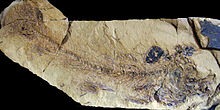
A fossilized skeleton found in Republic belonging to the Eocene salmon Eosalmo driftwoodensis
- Ephedra
- Epitonium
- †Epitonium berthiaumei
- †Epitonium clallamense
- †Epitonium olympicensis – or unidentified related form
- †Epitonium schencki
- Eponides
- Epophthalmia
- †Epophthalmia biordinata – type locality for species
Fossilized skull of the Oligocene-Miocene oreodont mammal Eporeodon - †Equisetum
- †Equisetum alexanderi - type locality for species[10]
- †Equisetum newberryi - type locality for species[7]
- Equus
- †Eratotrivia
- Erginus
- Eucommia[25]
Fossilized skeleton of the Miocene-Pliocene coyote-like canine Eucyon - Eulima
- †Eulimia
- Eupatagus
- †Eupatagus carolinensis – or unidentified related form
- Eurete
- †Eurete geoderti – tentative report
- †Eurete goederti
- Eurytellina
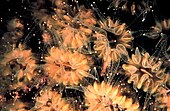
A living Eusmilia stony coral - †Eusmilia bainbridgensis – type locality for species
- Euspira
- †Eutrephoceras
- †Eutrephoceras eyerdami – type locality for species
- †Exilia
F
- Fagopsis[11]

Fossilized leaf found in Republic from the Eocene beech relative Fagopsis undulata
- Fagus
- Falsifusus – tentative report
- Farrea – tentative report
- Felis
- †Ficopsis
- †Ficopsis cowlitzensis
- †Ficopsis redmondi – or unidentified comparable form
- Ficus
- Flabellum
- †Flabellum californicum
- †Flabellum clarki
- †Flabellum hertleini – type locality for species
- †Florissantia
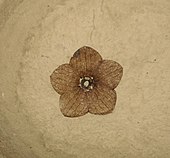
Fossilized calyx found in Republic from the Eocene mallow species Florissantia quilchenensis
- †Folindusia
- †Folindusia miocenica – type locality for species
- Fothergilla
- †Fothergilla durhamensis – type locality of species[8]
- †Fothergilla malloryi - type locality for species[20]
- Foveoscapha
- †Fraxinus[2]
- †Fraxinus yubaensis – or unidentified comparable form
- †Fucaia – type locality for genus
- †Fucaia buelli – type locality for species
- †Fucaia goedertorum – type locality for species
- Fulgoraria
- Fulgurofusus

A living Fusinus sea snail
G

Shell of a Galeodea helmet snail - Galeruca
- Galium
- Gari
- †Gari cowlitzensis
- †Gari hornii – or unidentified related form
- †Gari olequahensis
- Gastrophysa
- Gaudryina

Fossilized shell of a Gemmula sea snail, or gem turrid - Geodromicus
- Georissus
- Gerris
- Ginkgo[27]
- †Ginkgo beckii - type locality of the species[28]

An Eocene fossilized leaf found in Republic from the Eocene-modern ginkgo speciesGinkgo biloba - †Ginkgo dissecta[27]
- Gleditsia[3]
- †Gleditsia columbiana - type locality for species[3]
- Globigerina
- Globobulimina
- Globocassidulina
- Glycymeris
- †Glyphithyreus

Fossilized foliage of the cypress relative Glyptostrobus - †Goweria - type locality of genus[8]
- †Goweria dilleri[8]
- †Goweria linearis - type locality for species[8]
- Gryphus
- Guttulina
- Gymnusa
- Gyrineum
- Gyrinus
- Gyroidina
H
- †Hamamelites
- †Hamamelites voyana – or unidentified comparable form
- Hapalaraea
- Haplocochlias
- Haplophragmoides
- Helophorus
- †Helophorus lacustris
- †Helophorus oregonensis – or unidentified comparable form

Fossilized lower jaw of the Miocene-Pleistocene llama relative Hemiauchenia - †Hemiauchenia macrocephala – or unidentified comparable form
- Hemithiris
- Heptranchias
- Hesperibalanus
- †Hesperibalanus cornwalli – type locality for species
- †Hesperibalanus sookensis – or unidentified related form
- Heterlimnius
- Heterosilpha
- Hexactinella – tentative report
- †Hexactinella conica – type locality for species
- †Hexactinella tubula – type locality for species
- Hiatella
- Hiodon
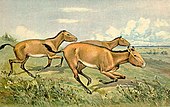
Life restoration of a herd of the Miocene-Pleistocene horse Hipparion. Heinrich Harder (1920). - Hipponix
- †Hippuris
- Homalopoma
- †Hoplictis
- †Humptulipsia - type locality for genus[31]
- †Humptulipsia raui - type locality for species[31]
- Hydrangea[2]
- Hydrobius
- Hydrothassa
- Hygrotus
- Hylurgops
- †Hymenarcys
- †Hymenarcys cridlandi – type locality for species
- Hyperbaena[8]
- †Hypertragulus
- †Hypolagus
- †Hypolagus edensis
- †Hypolagus furlongi
- †Hypolagus gidleyi
- †Hypolagus ringoldensis – type locality for species
- Hypserpa[8]
- †Hypserpa cashmanensis - type locality for species[8]
- †Hypserpa franklinensis - type locality for species[8]
I
- Idas
- Ilex[2]

Branches of a living Ilex opaca, or American holly, full of ripe fruit
- Ilybius
- †Involutina
- †Involutina incertus – or unidentified comparable form
- Ips
- Ischnochiton
- Ischnosoma
- Isochnus
- Isocrinus – tentative report
- Isognomon

A modern Isurus, or mako shark - Itea[11]
- †Ithyceroides – type locality for genus
- †Ithyceroides klondikensis – type locality for species
J
K
- Kalissus
- Katherinella
- Kellia
- †Klondikia – type locality for genus
- †Klondikia whiteae – type locality for species
A living Koelreuteria tree - †Kolponomos
- †Kronokotherium – tentative report
- †Kummelonautilus
- †Kummelonautilus cookanus – or unidentified related form
L
- Laccobius
- †Laccobius ellipticus – or unidentified comparable form
- Lamelliconcha
- Lampropeltis

Fossilized leaf found in Republic from the Eocene witch-hazel relative Langeria magnifica - †Langeria magnifica – type locality for species[11]
- Lanternarius – or unidentified comparable form
- Lapsus
- †Latahcoris – type locality for genus
- †Latahcoris spectatus – type locality for species
- Latirus
- Laurus
- †Leguminosites
- Leiodes
- Lemna
- Lenticulina
A living Lepidochitona chiton - Lepidophorus
- Lepidopleurus
- †Leptarctus
- Leptastrea – tentative report
- Leptochiton
- Lepyrus – or unidentified comparable form
- Leukoma
- †Libotonius[33]
- Lioligus
- Lioon
- Liothorax
- Liotia
- †Liotia washingtoniana – type locality for species

The autumn foliage of a living Liquidambar, or sweetgum tree - †Liquidambar californica – or unidentified comparable form
- †Liquidambar changii[34]
- †Litorhadia
- †Lophomastix
- Loricera
- Lucinoma
- †Lucinoma acutilineata
- †Lucinoma annulatum
- †Lucinoma columbiana – or unidentified comparable form
- †Lucinoma hannibali
- Lycopodium[2]
- Lygodium

A living Lynx - †Lynx canadensis
- †Lynx rufus – or unidentified comparable form
- Lyria
M
- Macaranga
- †Macaranga pugetensis – type locality for species[8][2]
- †Macclintockia
- †Macclintockia pugetensis – type locality for species[8]
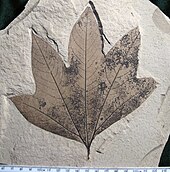
Fossilized leaf found in Republic from the Eocene plane tree relative Macginitiea gracilis - Macoma
- †Macoma albaria
- †Macoma astori
- †Macoma calcarea
- †Macoma inquinata
- †Macoma nasuta
- †Macoma secta – or unidentified related form
- †Macoma snohomishensis
- †Macoma sookensis
- †Macoma twinensis
- Macrocallista
- Mactromeris
- Madracis
- †Madracis crescentensis – type locality for species
- †Madracis stewarti – type locality for species
- Magdalis
- Magnolia
- †Mammut
- †Mammuthus
- †Mammuthus columbi

Life restorations of a Mammut americanum, or American mastodon (right), and a Mammuthus primigenius, or wooly mammoth (left)
- Marcia
- Margarites
- Marginella
- Marginulina
- Martinottiella
- †Megalonyx
- Megarthrus
- †Megatylopus
- †Megatylopus cochrani – or unidentified comparable form
- †Megistostoma
- †Megokkos[36]
- †Meibomites
- Melanoides
- †Menispermites
- †Menispermites parvareolatus – or unidentified comparable form
- †Menyanthes
- †Merycoides
- †Mesoreodon
- †Metacarcinus
- †Metanephrocerus
- †Metanephrocerus belgardeae – type locality for species[38]
- Metasequoia

Fossilized branchlet found in Republic from the Eocene dawn redwood Metasequoia occidentalis
- Microedus
- Microlestes
- Micropeplus
- †Miocordulia – type locality for genus
- †Miocordulia latipennis – type locality for species
- †Miohippus
- †Miohippus equiceps – or unidentified comparable form
- †Miohippus equinanus – tentative report
- †Miopsyche – type locality for genus
- †Miopsyche alexanderi – type locality for species
- †Miopsyche martynovi – type locality for species
- Mitra

Fossilized shell found in Vader; the hypotype specimen of the Eocene miter snail Mitra washingtoniana
- Modiolus
- †Modiolus restorationensis – or unidentified related form
- †Modiolus willapaensis
- †Molopophorus
- †Molopophorus newcombei – or unidentified related form
- Montipora
- †Montipora schencki – type locality for species
- Morychus
- Murex
- †Mursia
- Mustela
- †Mustela rexroadensis – or unidentified comparable form
- †Mya
- Mycetoporus
- Myriophyllum

Fossil queen or worker found in Republic from the Eocene bulldog ant form taxon Myrmeciites - Mytilus
- †Mytilus dichotomus
- †Mytilus edulis
- †Mytilus sammamishensis
- †Mytilus snohomishensis
- †Mytilus stillaguamishensis
- †Mytilus tichanovitchi – or unidentified related form
N
Multiple views of a fossilized shell belonging to a Natica moon snail - †Natica clarki – or unidentified comparable form
- †Natica oligocenica
- †Natica teglandae
- †Natica vokesi
- †Natica weaveri
- †Nayadina
- Nebria
- †Nekewis
- †Nekrolagus
- †Nekrolagus progressus – or unidentified comparable form
- Nemocardium
- †Neoephemera
- †Neoephemera antiqua – type locality for species[40]

A living Neotoma, or pack rat - †Neotoma fossilis – or unidentified comparable form
- †Neotoma quadriplicata – or unidentified comparable form
- Neptunea
- Nerita
- Neverita
- †Nitidavenus
- †Nitidavenus conradi – or unidentified comparable form
- Nitidotachinus
- †Nitidotachinus tachyporoides – or unidentified comparable form
- †Nolorhynchus
- Notaris
- Notiophilus
- Nucella
- †Nucleolaria
- †Nucleolaria cowlitziana – type locality for species
- Nucula
- Nuculana
- †Nuculana aikiensis
- †Nuculana alkiensis
- †Nuculana calkinsi
- †Nuculana chehalisensis
- †Nuculana cowlitzensis – or unidentified related form
- †Nuculana elmana – or unidentified comparable form
- †Nuculana grasslei
- †Nuculana vaderensis
- †Nuculana washingtoni
- Nuphar[41]

Fossilized wing found in Ferry County; the holotype specimen of the Eocene lacewing Nymphes georgei - †Nymphes georgei – type locality for species[42]
- Nyssa[2]
- †Nyssa eydei - type locality for species[5]
O
- Ochthebius
- †Ochthebius discretus
- †Ochthebius holmbergi – or unidentified comparable form
- Ocypus
- Odocoileus

Living male (right) and female (left) Odocoileus hemionus, or mule deer.
- Odostomia
- †Oecophylla
- †Oecophylla kraussei – type locality for species[43]
- Olivella
- Olophrum
- Ondatra
- Opalia
- Ophiodermella
- †Ophiomys
- Opisthius
- Orchestes
- Oreodytes – or unidentified comparable form
- Orobanus
- Orontium
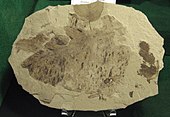
Fossilized leaf found in Ferry County belonging to the Eocene golden-club Orontium wolfei
- Oropus
- Osmunda[45]
- Ostrea
- Oxytelus
P
- †Pachycrommium
- †Paenemarmota
- †Paenemarmota sawrockensis – or unidentified comparable form
- Paguristes[46]
- †Palaeocarpinus[17]
- †Palaeohypotodus
- †Palaeolagus – or unidentified comparable form
- †Palaeopsychops

Eocene giant lacewing Palaeopsychops marringerae wing with color-patterning - †Palaeopsychops timmi – type locality for species
- †Paleoallium - type locality for genus
- †Paleoallium billgenseli - type locality for species[47]
- Paliurus
- Pandora
- Panopea
- Panthera – tentative report [citation needed]
- Panthera onca– tentative report [citation needed]
- †Paracryptotis
- Paracyathus
- †Paraenhydrocyon
- †Parailurus

Fossilized skeleton of the Pliocene-Pleistocene ground sloth Paramylodon - †Parastylotermes
- †Parastylotermes washingtonensis – type locality for species[48]
- Pardalosus
- Parvamussium
- Patelloida
- Patinopecten
- Patrobus
- Paulownia[2]
- †Paulownia columbiana - type locality for species[2]
- Pecten
- Pediastrum
- †Pedicularis
- Pelecomalium
- Pelenomus
- Pelophila
- †Pentacentron Manchester et al, 2018[49]
- †Pentacentron sternhartae Manchester et al, 2018[49]
- †Periope
- †Periope ivesi – type locality for species

A living Peromyscus, or deer mouse - †Perse – tentative report
- Persea
- Persicula
- Petrophyllia
- †Petrophyllia clarki
- †Petrophyllia weaveri – type locality for species
- Phaedon
- Phenacomys – or unidentified comparable form
- Phlaeopterus
- Phloeosinus
- †Phloeosinus keeni – or unidentified comparable form
- Phloeotribus
- †Phoebe[11]
- †Photinia

Fossilized leaf found in Republic from the Eocene rose relative Photinia pagae
- Phryganea
- †Phryganea spokanensis – type locality for species
- Phytocrene
- †Phytocrene acutissima – or unidentified comparable form
- Picea[2]
- Pinus[2]
- Pitar
- †Pitar avenalensis
- †Pitar californiana
- †Pitar quadratus
- †Pitar soledadensis – or unidentified comparable form
- †Pitar wasana
- Pituophis
- Pityophthorus
- †Pityophthorus digestus – or unidentified comparable form
- †Pityophthorus nitidulus
- †Plafkeria
- †Plafkeria rentonensis – or unidentified comparable form
- Plagiocardium
- Planolinoides
- Plantago
- Platanus[2]
- †Platanus americana - type locality for species[3]
- †Platanus dissecta[2]
- Plateumaris
- Platycarya
- †Platycarya pseudobrauni – or unidentified comparable form

Restoration of a herd of alarmed Miocene-Pleistocene peccaries of the genus Platygonus. Charles R. Knight (1922). - †Platyopuntia
- Platystethus
- Plectofrondicularia
- †Plectofrondicularia vaughani – or unidentified comparable form
- †Plionarctos
- †Plionarctos harroldorum – type locality for species
- Polinices
- Polygonum
- Polypodium – tentative report
- †Polystoechotites[51]

Fossilized wing found in Republic; the holotype specimen of the Eocene giant lacewing Polystoechotites barksdalae - †Polystoechotites falcatus - type locality for species[51]
- †Polystoechotites lewisi - type locality for species[51]
- Populus
- Poromya
- Portlandia
- †Potamides
- Potamogeton[2]
- †Potentilla

Fossilized skeleton of the Eocene perch Priscacara - †Priscacara campi – type locality for species
- †Priscofusus
- †Priscofusus chehalisensis
- †Priscofusus geniculus – or unidentified related form
- †Priscofusus goweri
- †Priscofusus sanctaecrucis
- †Priscofusus slipensis
- †Priscofusus stewarti
- †Procastoroides
- †Procastoroides idahoensis – or unidentified comparable form
- Procyon – tentative report
- †Prodipodomys

Life restoration of the Miocene hippopotamus-like oreodont Promerycochoerus both onshore and in the water. Robert Bruce Horsfall (1913). - †Proneuronema[52]
- †Proneuronema wehri - type locality for species[52]
- †Propalosoma – type locality for genus[53]
- †Propalosoma gutierrezae - type locality for species[53]
- †Prosthennops
- Proteinus
- †Provanna
- Prunus
- Psammacoma
- Pselaptrichus
- †Pseudoglandulina
- †Pseudoglandulina inflata – or unidentified comparable form
- Pseudohylesinus
- †Pseudohylesinus nebulosus
- †Pseudohylesinus sericeus – or unidentified comparable form
- Pseudolarix[citation needed]

Fossilized wing seed found in Republic from the Eocene golden larch species Pseudolarix wehrii
- Pseudoliva
- Pseudopsis
- †Pseudopsis sulcata - or unidentified loosely related form
- Pteria
- †Pteria clarki
- †Pteria pellucida – or unidentified comparable form
- Pteris
- †Pteris whatcomensis -type locality for species[7]
- Pterocarya[2]
- †Pterocarya mixta - type locality for species[10]
- †Pterocarya pugetensis – type locality for species[8]
- Pterostichus
- †Pterostichus adstrictus
- †Pterostichus castaneus
- †Pterostichus fernquisti – type locality for species
- †Pterostichus pumilus
- †Pterostichus riparius
- †Pteronepelys[54]
- Pteryngium
- Pterynotus
- †Pterynotus washingtonicus – type locality for species
- †Pugetia - type locality for genus[8]
- †Pugetia longifolia – type locality for species[8]
- Puma
- Puma concolor – tentative report
- Purpura
- Pycnoglypta
- Pyramidella
- Pyrgo
- †Pyrgo lupheri – or unidentified comparable form
Q
- Quedius

A living Quercus, or oak tree - †Quercus cognatus
- †Quercus hiholensis[55]
- †Quercus leuca - type locality for species[3]
- †Quercus sahnii - type locality for species[5]
- †Quercus simulata
- †Quercus treleasii
- Quinqueloculina
- †Quinqueloculina imperalis
- †Quinqueloculina imperialis
- †Quinqueloculina minuta – or unidentified comparable form
R
- Rangifer
Fossilized carapace of the Paleogene-modern crab Ranina - Raninoides
- Ranunculus
- Rectiplanes – tentative report
- Reichenbachia
- †Republica – type locality for genus[11]
- †Republica hickeyi - type locality for species[11][11]
- †Republica kummerensis - type locality for species[8][11]
- †Republica litseafolia[8][11]
- Retusa
- †Rhamnites[8]
- †Rhamnites cashmanensis - type locality for species[8]
- †Rhamnites franklinensis - type locality for species[8]
- Rhantus

Fossilized compound leaf from an Eocene sumac Rhus hybrid - †Rhus boothillensis - type locality for species[56]
- †Rhus garwellii - type locality for species[56]
- †Rhus malloryi – type locality for species[11][56]
- †Rhus republicensis - type locality for species[56]
- †Rhus typhina – or unidentified comparable form
- †Rhynchonella
- Rhyncolus
- †Rhyncolus brunneus
- †Rhysocaryoxylon[3][57]
- †Rhysocaryoxylon fryxellii - type locality for species[5][57]
- †Rhysocaryoxylon tertiarum - type locality for species[3][57]
- †Ribes
- Rimella
- Rinorea – or unidentified comparable form
- Robulus
- †Robulus texanus – or unidentified comparable form
- Rosa
- †Rotularia
- Rumohra
- †Rumohra bartonae - type locality for species[7]
S

Fossilized fronds from Sabalites campbelli - Saldula
- Salix[2]
- †Salix heartensis – or unidentified comparable form
- †Salix spokanensis - type locality for species[10]
- Salpichlaena[7]
- †Salvinia
- †Salvinia preauriculata – or unidentified comparable form
- †Sarcobatus
- Sassafras

Fossilized leaf of the Eocene sassafras Sassafras hesperia
- †Satherium
- Saxidomus
- Scalina
- Scapanus
- Scaphander
- Scaphinotus
- Schizaster
- †Schoepfia
- †Schoepfia republicensis - type locality for species[11]
- †Scirpus
- Sclerhelia – tentative report
- Selaginella[2]
- Semicassis
- Septifer
- Serripes
- †Shepherdia
Berries and foliage of a living Shepherdia canadensis, or Canada buffaloberry
- †Shirleya[58]
- Siderastrea
- †Siderastrea vancouverensis – or unidentified comparable form
- †Siderastrea washingtonensis – type locality for species
- Sigmomorphina
- Sinum
- †Sinum obliquum
- †Sinum occidentalis – or unidentified related form
- †Sinum scopulosum
Shell of the whelk sea snail Siphonalia - Sitona
- †Sitsqwayk
- †Sitsqwayk cornishorum – type locality for species
- Smilax
- Solamen
- Solariella
- Solen
- Solena
- †Solena clarki
- †Solena columbina
- †Solena conradi
- †Solena parallelus – or unidentified comparable form
- Sonoma

A living Sorex, or long-tailed shrew - †Sorex meltoni – or unidentified comparable form
- †Sorex powersi
- †Sparganium
- Spermophilus
- †Spermophilus howelli – or unidentified comparable form
- †Spermophilus russelli
- Spilogale
- †Spirocrypta
- Spirotropis
Shell of a Spisula, or surf clam - †Spisula hannibali – or unidentified comparable form
- †Spisula packardi
- †Spisula sookensis
- †Spisula twinensis
- Spondylus
- †Squaloziphius – type locality for genus
- †Squaloziphius emlongi – type locality for species

A living Squalus, or spurdog - Stenoplax
- Stenus
- Stephanocyathus
- †Stephanocyathus holcombensis – type locality for species
- Stephostethus
- Steremnius
- Sthereus

A living Stylaster hydroid - †Stylaster milleri – type locality for species
- †Sulcobuccinum
- Surculites
- †Surculites mathewsoni
- †Surculites wynoocheensis – tentative report
- Sveltella
- †Sveltella keaseyensis – tentative report
- Syntomium
- †Syntomium malkini – or unidentified comparable form
- Syntomus
T
- Tachinus
- †Tachinus angustatus
- †Tachinus crotchii
- †Tachinus frigidus
- †Tachinus instabilis – or unidentified comparable form
- †Tachinus mimus
- †Tachinus thruppi
- †Tauntonophis – type locality for genus
- †Tauntonophis morganorum – type locality for species
- Taxidea
- Taxodium
- †Tejonia

Restoration of the Miocene-Pliocene rhinoceros Teleoceras - †Teleoceras hicksi
- †Teleoceras major – or unidentified comparable form
- Tellina
- Tenagodus
- Terebratulina
- Teredo
- †Ternstroemites
- †Ternstroemites ravenensis – type locality for species[8]
- Tetracentron [49]

Tetracentron hopkinsii leaf, Ypresian Klondike Mountain Formation
- †Tetrapleuroxylon[59]
- †Tetrapleuroxylon vantagiensis - type locality for species[3][59]
- Tetrascapha
- Thais
- †Thalictrum

A living Thamnophis, or garter snake - Thanatophilus
- Thomomys
- †Thomomys gidleyi – or unidentified comparable form
- Thracia
- Thyasira
- †Thyasira folgeri
- †Thyasira hannibali
- †Thyasira peruviana – tentative report
- Tilia

Fossilized leaf found in Republic from the Eocene basswood tree Tilia johnsoni
- Tipula
- †Tipula latahensis – type locality for species
- †Tivelina
- †Tonsala – type locality for genus
- †Tonsala buchanani – type locality for species
- †Tonsala hildegardae – type locality for species
- Tournotaris
- †Tournotaris bimaculatus – or unidentified comparable form
- Trechiama – or unidentified related form
- Trechus
- †Trechus chalybeus
- †Trechus oregonensis
- †Trechus ovipennis – or unidentified comparable form
- Tresus
- Trichalophus
- †Trigonictis
- Trichopeltarion
- Trochita
- Trochocyathus
- †Trochocyathus crooki
- †Trochocyathus nomlandi
- †Trochocyathus townsendensis – type locality for species
- Trochodendron[60]
- Trophon
- Trypophloeus
- †Tsuga[2]
- †Tsukada – type locality for genus[11]
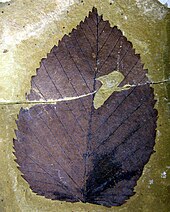
Fossilized leaf found in Republic from the Eocene dove tree relative Tsukada davidiifolia
- Tubastraea
- †Tubastraea nomlandi – type locality for species
- Tudicla
- †Turbinolia
- †Turbinolia quaylei – type locality for species
- †Turbinolia weaveri – type locality for species
- †Turbinolina
- Turcica
- †Turcicula
- Turricula
- Turris

Fossilized shells of the Late Jurassic-modern tower snail Turritella - †Turritella andersoni
- †Turritella blakeleyensis
- †Turritella buwaldana – or unidentified comparable form
- †Turritella oregonensis
- †Turritella porterensis
- †Turritella uvasana
- †Turritella vaderensis – or unidentified comparable form
- †Turritella wasana
- Typha
U

- †Ulmeriella
- †Ulmeriella latahensis – type locality for species
- Ulmus[2]
- †Ulmus baileyana - type locality for species[5]
- †Ulmus chuchuanus[61]
- †Ulmus miocenica - type locality for species[3]

Ulmus okanaganensis leaf, Ypresian Klondike Mountain Formation - †Ulmus oregoniana[8][2]
- †Ulmus pacifica - type locality for species[3]
- †Ulmus paucidentata[2]
- †Ulmus speciosa[2]
- †Ulteramus – type locality for genus[62]
- †Ulteramus republicensis – type locality for species[62]
- Unamis
- Upogebia
- †Upogebia barti - type locality for species[16]
- †Upogebia eocenica - type locality for species[16]
- Urosalpinx
- Utricularia
- Uvigerina
V
- Venericardia
- †Venericardia castor
- †Venericardia clarki
- †Venericardia hannai
- †Venericardia hornii
- †Venericardia weaveri – or unidentified comparable form
- †Vertipecten
- Vesicomya
- Viburnum[8]
- †Viburnum pugetensis – type locality for species[8]
- †Vinea - type locality for genus[8]
- †Vinea pugetensis – type locality of species[8]

Leaves and fruit of a living Vitis, or grapevine - Volsella
W
- †Wessiea[63]
- †Willisia - type locality for genus[8]
- †Willisia rentonensis - type locality for species[8]
- †Whitneyella
- Woodwardia[2][63]
- †Woodwardia aurora - type locality for species[7]
- †Woodwardia clarus - type locality for species[7]
- Woodwardia virginica[63]
X
Y
- Yoldia
- †Yoldia chehalisensis
- †Yoldia clallamensis – type locality for species
- †Yoldia duprei
- †Yoldia newcombi
- †Yoldia olympiana
- †Yoldia reagani
- †Yoldia sammamishensis
- †Yoldia supramontereyensis
Z
- Zannichellia

Living Zannichellia palustris, or horned pondweed
- †Zanthopsis
- †Zarhinocetus
- †Zarhinocetus donnamatsonae – type locality for species
- Zelkova
- †Zingiberopsis
- †Zingiberopsis isonervosa – or unidentified comparable form
References
- ^ Schorn, Howard; Wehr, Wesley (1986). "Abies milleri, sp. nov., from the Middle Eocene Klondike Mountain Formation, Republic, Ferry County, Washington". Burke Museum Contributions in Anthropology and Natural History (1): 1–7.
- ^ a b c d e f g h i j k l m n o p q r s t u v w x y z aa ab ac ad ae af ag ah ai aj ak al Dillhoff, R.M.; Dillhoff, T.A.; Jijina, A.P.; Strömberg, C.A.E. (2014). "The Vasa Park flora, King County, Washington, USA – a window into the late Miocene of the Pacific Northwest". In Stevens, W.D.; Montiel, O.M.; Raven, P.H. (eds.). Paleobotany and Biogrography, A Festschrift for Alan Graham in His 80th Year. Missouri Botanical Garden Press. pp. 64–97.
- ^ a b c d e f g h i j k l m n Prakash, U.; Barghoorn, E. S. (1961). "Miocene fossil woods from the Columbia Basalts of central Washington". Journal of the Arnold Arboretum. 42 (2): 165–203. doi:10.5962/bhl.part.19013.
- ^ a b c d e f g h i j k l m n o Wolfe, J.A.; Tanai, T. (1987). "Systematics, Phylogeny, and Distribution of Acer (maples) in the Cenozoic of Western North America". Journal of the Faculty of Science, Hokkaido University. Series 4, Geology and Mineralogy. 22 (1): 23, 74, 75, 240, & plate 4.
- ^ a b c d e Prakash, U.; Barghoorn, E. S. (1961). "Miocene fossil woods from the Columbia Basalts of central Washington, II". Journal of the Arnold Arboretum. 42 (3): 347–362. doi:10.5962/bhl.part.19013.
- ^ a b Makarkin, V.; Archibald, S.B. (2014). "An unusual new fossil genus probably belonging to the Psychopsidae (Neuroptera) from the Eocene Okanagan Highlands, western North America" (PDF). Zootaxa. 3838 (3): 385–391. CiteSeerX 10.1.1.692.1185. doi:10.11646/zootaxa.3838.3.8. PMID 25081783.
- ^ a b c d e f g h i j k l m n o p q r s t u v w Pabst, M. B. (1968). "The flora of the Chuckanut Formation—the Equisitales. Filicales, and Coniferales". University of California Publications in Geological Sciences. 76 (85).
- ^ a b c d e f g h i j k l m n o p q r s t u v w x y z aa ab ac ad ae af ag ah ai aj ak al am an ao Wolfe, J.A. (1968), "Paleogene Biostratigraphy of Nonmarine Rocks in King County, Washington", United States Geological Survey Bulletin, 571: 1–29
- ^ a b Vladimir N. Makarkin & S. Bruce Archibald (2009). "A new genus and first Cenozoic fossil record of moth lacewings (Neuroptera: Ithonidae) from the Early Eocene of North America" (PDF). Zootaxa. 2063: 55–63. doi:10.11646/zootaxa.2063.1.3.
- ^ a b c d e f g Berry, E.W. 1936 "A revision of the flora of the Latah Formation", United states Geological Survey Professional paper number 154-H.
- ^ a b c d e f g h i j k l m n o p q r s t u v w x y z aa Wolfe, J.A.; Wehr, W.C. (1987). "Middle Eocene dicotyledonous plants from Republic, northeastern Washington". United States Geological Survey Bulletin. 1597: 1–25.
- ^ a b c d e Wilson, MVH (1977). "Middle Eocene freshwater fishes from British Columbia". Life Sciences Contributions, Royal Ontario Museum. 113: 1–66.
- ^ Arnold, C. A. (1955). "A Tertiary Azolla from British Columbia" (PDF). Contributions from the Museum of Paleontology, University of Michigan. 12 (4): 37–45.
- ^ a b B. K. Shipps; Carlos Mauricio Peredo; Nicholas D. Pyenson (2019). "Borealodon osedax, a new stem mysticete (Mammalia, Cetacea) from the Oligocene of Washington State and its implications for fossil whale-fall communities". Royal Society Open Science. 6 (7): Article ID 182168. Bibcode:2019RSOS....682168S. doi:10.1098/rsos.182168. PMC 6689636. PMID 31417706.
- ^ Herendeen, P. S.; Dilcher, D. L. (1991). "Caesalpinia subgenus Mezoneuron (Leguminosae, Caesalpinioideae) from the Tertiary of North America". American Journal of Botany. 78 (1): 1–12. doi:10.1002/j.1537-2197.1991.tb12566.x. JSTOR 2445223.
- ^ a b c d e Fraaije, R. H.; van Bakel, B. W.; Jagt, J. W.; Coole, Y. (2006). "Two new Paleogene species of mud shrimp (Crustacea, Decapoda, Upogebiidae) from Europe and North America". Bulletin of the Mizunami Fossil Museum. 33: 77–85.
- ^ a b c d e f Pigg, K.B.; Manchester, S.R.; Wehr, W.C. (2003). "Corylus, Carpinus, and Palaeocarpinus (Betulaceae) from the Middle Eocene Klondike Mountain and Allenby Formations of Northwestern North America". International Journal of Plant Sciences. 164 (5): 807–822. doi:10.1086/376816.
- ^ Manchester, S.R. (1987). "The fossil history of the Juglandaceae". Monographs in Systematic Botany. 21: 1–137.
- ^ Shi, G.; Zhou, Z.; Xie, Z. (2010). "A new Cephalotaxus and associated epiphyllous fungi from the Oligocene of Guangxi, South China". Review of Palaeobotany and Palynology. 161 (3–4): 179–195. doi:10.1016/j.revpalbo.2010.04.002.
- ^ a b c Radtke, M.G.; Pigg, K.B.; Wehr, W.C. (2005). "Fossil Corylopsis and Fothergilla Leaves (Hamamelidaceae) from the Lower Eocene Flora of Republic, Washington, U.S.A., and Their Evolutionary and Biogeographic Significance". International Journal of Plant Sciences. 166 (2): 347–356. doi:10.1086/427483.
- ^ a b Manchester, S.; Pigg, K. (2008). "The Eocene mystery flower of McAbee, British Columbia". Botany. 86 (9): 1034–1038. doi:10.1139/B08-044.
- ^ a b c d Archibald, S.B. (2005). "New Dinopanorpidae (Insecta: Mecoptera) from the Eocene Okanagan Highlands (British Columbia, Canada and Washington State, USA)". Canadian Journal of Earth Sciences. 42 (2): 119–136. Bibcode:2005CaJES..42..119A. doi:10.1139/e04-073.
- ^ a b Andrei A. Legalov (2013). "New and little known weevils (Coleoptera: Curculionoidea) from the Paleogene and Neogene". Historical Biology: An International Journal of Paleobiology. 25 (1): 59–80. doi:10.1080/08912963.2012.692681.
- ^ a b Archibald, SB; Bradler, S (2015). "Stem-group stick insects (Phasmatodea) in the early Eocene at McAbee, British Columbia, Canada, and Republic, Washington, United States of America". The Canadian Entomologist. 147 (6): 744. doi:10.4039/tce.2015.2.
- ^ a b Call, V.B.; Dilcher, D.L. (1997). "The fossil record of Eucommia (Eucommiaceae) in North America" (PDF). American Journal of Botany. 84 (6): 798–814. doi:10.2307/2445816. JSTOR 2445816. PMID 21708632.
- ^ Manchester, S. R. (1992). "Flowers, fruits and pollen of Florissantia, an extinct malvalean genus from the Eocene and Oligocene of western North America". American Journal of Botany. 79 (9): 996–1008. doi:10.2307/2444909. JSTOR 2444909.
- ^ a b c Mustoe, G.E. (2002). "Eocene Ginkgo leaf fossils from the Pacific Northwest". Canadian Journal of Botany. 80 (10): 1078–1087. doi:10.1139/b02-097.
- ^ Scott, R. A.; Barghoorn, E. S.; Prakash, U. (1962). "Wood of Ginkgo in the Tertiary of western North America". American Journal of Botany. 49 (10): 1095–1101. doi:10.1002/j.1537-2197.1962.tb15052.x. JSTOR 2439157.
- ^ LePage, B. A. (2007). "The taxonomy and biogeographic history of Glyptostrobus Endlicher (Cupressaceae)". Bulletin of the Peabody Museum of Natural History. 48 (2): 359–426. doi:10.3374/0079-032x(2007)48[359:ttabho]2.0.co;2.
- ^ Hilton, E. J.; Grande, L. (2008). "Fossil Mooneyes (Teleostei: Hiodontiformes, Hiodontidae) from the Eocene of western North America, with a reassessment of their taxonomy". Geological Society, London, Special Publications. 295 (1): 221–251. Bibcode:2008GSLSP.295..221H. doi:10.1144/sp295.13.
- ^ a b Kiel, S. (2008). "An unusual new gastropod from an Eocene hydrocarbon seep in Washington state". Journal of Paleontology. 82 (1): 188–191. doi:10.1666/06-029.1.
- ^ Wang, Q.; Manchester, S. R.; Gregor, H. J.; Shen, S.; Li, Z. Y. (2013). "Fruits of Koelreuteria (Sapindaceae) from the Cenozoic throughout the northern hemisphere: their ecological, evolutionary, and biogeographic implications". American Journal of Botany. 100 (2): 422–449. doi:10.3732/ajb.1200415. PMID 23360930.
- ^ a b Wilson, M. V. H. (1979). "A Second Species of Libotonius (Pisces: Percopsidae) from the Eocene of Washington State". Copeia. 1979 (3): 400–405. doi:10.2307/1443214. JSTOR 1443214.
- ^ Pigg, K. B.; Ickert-Bond, S. M.; Wen, J. (2004). "Anatomically preserved Liquidambar (Altingiaceae) from the middle Miocene of Yakima Canyon, Washington state, USA, and its biogeographic implications". American Journal of Botany. 91 (3): 499–509. doi:10.3732/ajb.91.3.499. PMID 21653405.
- ^ a b NW palms
- ^ a b c d Schweitzer, C. E.; Iturralde-Vinent, M.; Hetler, J. L.; Velez-Juarbe, J. (2006). "Oligocene and Miocene decapods (Thalassinidea and Brachyura) from the Caribbean". Annals of Carnegie Museum. 75 (2): 111–136. doi:10.2992/0097-4463(2006)75[111:oamdta]2.0.co;2.
- ^ Ross E. Berglund & James L. Goedert (1996). "A new crab (Brachyura: Cancridae) from Lower Miocene rocks of the Northwestern Olympic Peninsula, Washington". Journal of Paleontology. 70 (5): 830–835. doi:10.1017/S0022336000023866. JSTOR 1306484.
- ^ Archibald, SB; Kehlmaier, C; Mathewes, RW (2014). "Early Eocene big headed flies (Diptera: Pipunculidae) from the Okanagan Highlands, western North America". The Canadian Entomologist. 146 (4): 429–443. doi:10.4039/tce.2013.79.
- ^ Archibald, S.B.; Cover, S. P.; Moreau, C. S. (2006). "Bulldog Ants of the Eocene Okanagan Highlands and History of the Subfamily (Hymenoptera: Formicidae: Myrmeciinae)" (PDF). Annals of the Entomological Society of America. 99 (3): 487–523. doi:10.1603/0013-8746(2006)99[487:BAOTEO]2.0.CO;2.
- ^ Sinitchenkova, N. D. (1999). "A new mayfly species of the extant genus Neoephemera from the Eocene of North America (Insecta: Ephemerida=Ephemeroptera)" (PDF). Paleontological Journal. 33 (4): 403–405. Archived from the original (PDF) on 2011-09-30.
- ^ a b DeVore, ML; Taylor, W; Pigg, KB (2015). "Nuphar carlquistii sp. nov. (Nymphaeaceae): A Water Lily from the Latest Early Eocene, Republic, Washington". International Journal of Plant Sciences. 176 (4): 365–377. doi:10.1086/680482.
- ^ a b Archibald, S. B.; Makarkin, V. N.; Ansorge, J. (2009). "New fossil species of Nymphidae (Neuroptera) from the Eocene of North America and Europe" (PDF). Zootaxa. 2157: 59–68. doi:10.11646/zootaxa.2157.1.4.
- ^ Perfilieva, K. S.; Dubovikoff, D. A.; Dlussky, G. M. (2017). "Miocene ants (Hymenoptera, Formicidae) from Crimea". Paleontological Journal. 51 (4): 391–401. doi:10.1134/s0031030117040098.
- ^ Bogner, J.; Johnson, K. R.; Kvacek, Z.; Upchurch, G. R. (2007). "New fossil leaves of Araceae from the Late Cretaceous and Paleogene of western North America" (PDF). Zitteliana. A (47): 133–147. ISSN 1612-412X.
- ^ a b Miller, C.N. jr. (1982). "Osmunda wehrii, a New Species Based on Petrified Rhizomes from the Miocene of Washington". American Journal of Botany. 69 (1): 116–121. doi:10.2307/2442836. JSTOR 2442836.
- ^ a b Karasawa, H.; Fudouji, Y. (2018). "Two new species of hermit crabs (Decapoda: Anomura) from the Paleogene Kishima Group, Saga Prefecture, Japan". Bulletin of the Mizunami Fossil Museum. 44: 23–28.
- ^ Pigg, K. B.; Bryan, F. A.; DeVore, M. L. (2018). "Paleoallium billgenseli gen. et sp. nov.: Fossil Monocot Remains from the Latest Early Eocene Republic Flora, Northeastern Washington State, USA". International Journal of Plant Sciences. 179 (6): 477–486. doi:10.1086/697898.
- ^ Engel, M.S.; Grimaldi, D.A.; Nascimbene, P.C.; Singh, H. (2011). "The termites of Early Eocene Cambay amber, with the earliest record of the Termitidae (Isoptera)". ZooKeys (148): 105–123. doi:10.3897/zookeys.148.1797. PMC 3264413. PMID 22287892.
{{cite journal}}: CS1 maint: unflagged free DOI (link) - ^ a b c d Manchester, S.; Pigg, K. B.; Kvaček, Z; DeVore, M. L.; Dillhoff, R. M. (2018). "Newly recognized diversity in Trochodendraceae from the Eocene of western North America". International Journal of Plant Sciences. 179 (8): 663–676. doi:10.1086/699282.
- ^ Kvaček, Z.; Dašková, J.; Zetter, R. (2004). "A re-examination of Cenozoic Polypodium in North America". Review of Palaeobotany and Palynology. 128 (3–4): 219–227. doi:10.1016/s0034-6667(03)00134-9.
- ^ a b c d Archibald, S.B.; Makarkin V.N. (2006). "Tertiary Giant Lacewings (Neuroptera: Polystechotidae): Revision and Description of New Taxa From Western North America and Denmark". Journal of Systematic Palaeontology. 4 (2): 119–155. doi:10.1017/S1477201906001817. Retrieved January 27, 2010.
- ^ a b Vladimir N. Makarkin; Sonja Wedmann; Thomas Weiterschan (2016). "A new genus of Hemerobiidae (Neuroptera) from Baltic amber, with a critical review of the Cenozoic Megalomus-like taxa and remarks on the wing venation variability of the family". Zootaxa. 4179 (3): 345–370. doi:10.11646/zootaxa.4179.3.2. PMID 27811679.
- ^ a b Dlussky, G. M.; Rasnitsyn, A. P. (1999). "Two new species of aculeate hymenopterans (Vespida=Hymenoptera) from the Middle Eocene of the United States". Paleontological Journal. 33: 546–549.
- ^ a b Manchester, S.R. (1994). "Fruits and Seeds of the Middle Eocene Nut Beds Flora, Clarno Formation, Oregon". Palaeontographica Americana. 58: 30–31.
- ^ Borgardt, S. J.; Pigg, K. B. (1999). "Anatomical and developmental study of petrified Quercus (Fagaceae) fruits from the Middle Miocene, Yakima Canyon, Washington, USA". American Journal of Botany. 86 (3): 307–325. doi:10.2307/2656753. JSTOR 2656753.
- ^ a b c d Flynn, S.; DeVore, M. L.; Pigg, K. B. (2019). "Morphological Features of Sumac Leaves (Rhus, Anacardiaceae), from the Latest Early Eocene Flora of Republic, Washington". International Journal of Plant Sciences. 180 (6): 464–478. doi:10.1086/703526.
- ^ a b c Blokhina, N. I. (2007). "Fossil wood of the Juglandaceae: Some questions of taxonomy, evolution, and phylogeny in the family based on wood anatomy" (PDF). Paleontological Journal. 41 (11): 1040–1053. doi:10.1134/s0031030107110032.
- ^ a b Pigg, K. B.; DeVore, M. L. (2005). "Shirleya grahamae gen. et sp. nov.(Lythraceae), Lagerstroemia-like fruits from the middle Miocene Yakima Canyon flora, central Washington State, USA". American Journal of Botany. 92 (2): 242–251. doi:10.3732/ajb.92.2.242. PMID 21652401.
- ^ a b Soomro, N.; Arain, B. A.; Rajput, M. T. M. (2016). "Albizzioxylon chinjiensis sp. nov., a new fossil species of the family Leguminosae from Chinji formation salt range, Punjab Pakistan". International Journal. 11 (28): 2838–2843.
- ^ a b Pigg, K.B.; Wehr, W.C.; Ickert-Bond, S.M. (2001). "Trochodendron and Nordenskioldia (Trochodendraceae) from the Middle Eocene of Washington State, U.S.A". International Journal of Plant Sciences. 162 (5): 1187–1198. doi:10.1086/321927.
- ^ a b Denk, T.; Dillhoff, R.M. (2005). "Ulmus leaves and fruits from the Early-Middle Eocene of northwestern North America: systematics and implications for character evolution within Ulmaceae" (PDF). Canadian Journal of Botany. 83 (12): 1663–1681. doi:10.1139/b05-122.
- ^ a b Archibald, S.B.; Rasnitsyn, A.P. (2015). "New early Eocene Siricomorpha (Hymenoptera: Symphyta: Pamphiliidae, Siricidae, Cephidae) from the Okanagan Highlands, western North America". The Canadian Entomologist. 148 (2): 209–228. doi:10.4039/tce.2015.55.
- ^ a b c d Pigg, K.B. (2001). "Anatomically preserved Woodwardia virginica (Blechnaceae) and a new Filicalean fern from the Middle Miocene Yakima Canyon Flora of central Washington, USA". American Journal of Botany. 88 (5): 777–787. doi:10.2307/2657030. JSTOR 2657030.
Uncited entries
- Various Contributors to the Paleobiology Database. "Fossilworks: Gateway to the Paleobiology Database". Retrieved 7 August 2017.
{{cite web}}:|author=has generic name (help)



























































































